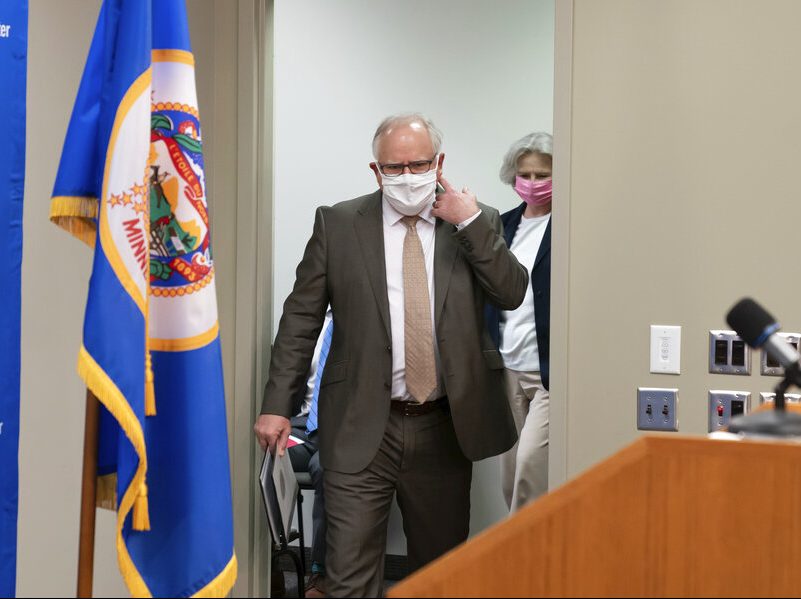
Minnesota Governor Tim Walz arrives to speak at a news conference about the state’s response to the coronavirus outbreak Wednesday, May 20, 2020. Restaurants and bars may reopen June 1 for outdoor dining with social distancing and other safeguards in place, while salons and barbershops will also be allowed to resume business at partial capacity. (Glen Stubbe/Star Tribune via AP, Pool)
MINNEAPOLIS (AP) — Minnesota restaurants and bars may reopen June 1 for outdoor dining with social distancing and other safeguards, while salons can resume cutting hair at partial capacity, Gov. Tim Walz said Wednesday, drawing sharp criticism from those who had hoped for faster steps to help struggling businesses.
It was Walz’s latest move to “turn the dial” in a gradual return to normal since the coronavirus pandemic cost hundreds of thousands of Minnesotans their jobs within a few weeks. He said the slow pace reflects the need to prepare for the coming stresses on the health care system as COVID-19 cases peak in the coming weeks.
The governor said he empathized with “how maddening this is, how frustrating it is” for Minnesotans not to be able to do the things they enjoy. But social distancing, hand-washing, wearing masks and getting tested when one has symptoms of COVID-19 are things that people can control, he said.
Bars, restaurants, personal care services and other nonessential businesses have been shut down since mid-March, though eateries have been allowed to offer take-out and delivery service. When restaurants and bars reopen, they’ll have to operate with limited seating capacity and space tables 6 feet apart, Economic Development Commissioner Steve Grove said. Parties will be limited to four people, or six for families. Staff must wear masks and guests are strongly encouraged to do so, except while eating and drinking. Reservations will be required.
The state is encouraging communities to find innovative ways to provide more outdoor seating, particularly for establishments without decks or patios. Some communities have already discussed closing streets or sidewalks to provide more space.
Masks, limited seating and reservations will also be required at hair salons, barber shops, nail salons and tattoo parlors as they start reopening June 1, Grove said. Campgrounds and charter boats can also reopen with social distancing and other safety measures starting June 1, meaning they’ll miss the Memorial Day weekend, one of their busiest times of the year.
But gyms, theaters, bowling alleys and churches still must wait for word on when they can start getting back to normal, the commissioner said. Businesses eventually will be allowed to let more people inside and larger outdoor gatherings will be permitted. Some outdoor entertainment will be allowed, such as movies in the parks. Pools will be allowed to open at 50% capacity at some point. Eventually, religious services with over 10 people can move inside.
Grove was unable to say when or even if full-scale youth sports and overnight youth camps can reopen this summer.
The Democratic governor, who has drawn increasing criticism from Republicans and businesses for his cautious approach, quickly came under even more fire.
“We understand the focus on safety, and so do businesses that have protection plans in place and are ready to open,” Doug Loon, president of the Minnesota Chamber of Commerce, said in a statement. “The approach announced today doesn’t sufficiently recognize the ability of businesses — many of them small businesses — to innovate and protect employees and customers.”
Without quick action to allow more reopenings, he said, many businesses will be unable to return.
“What is the science that allows indoor salon services but restricts restaurants to outdoor seating?” Republican House Minority Leader Kurt Daudt, of Crown, asked in a statement. “Why are churches limited to 10 people outdoors while hundreds of people can gather in the aisles of big box stores?”
The Minnesota Department of Health on Wednesday reported 29 more COVID-19 deaths, the second-highest one-day death toll of the pandemic. The new deaths raised the state’s total to 777. The department also reported 645 new confirmed cases for a total of 17,670.
For most people, the new coronavirus causes mild or moderate symptoms, such as fever and cough that clear up in two to three weeks. For some, especially older adults and people with existing health problems, it can cause more severe illness, including pneumonia and death.
The governor said the growing death toll in Minnesota and the experiences of harder-hit states like New York have weighed heavily in his decision to go slow.
“It’s just so bitterly heartbreaking and frustrating to know that in eight days we’ll pass 1,000 (deaths) and in another 20 days of we keep at the same pace we’ll pass 1,500,” he said.
